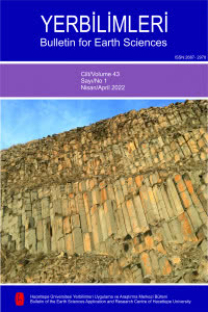GPS ölçümlerine dayanılarak Türkiye' nin yıllık birim deformasyon ve gerilim hızı dağılımının değerlendirilmesi
Bu çalışmada, GPS ölçümlerinden elde edilen yerdeğiştirme hızlarından yararlanılarak yerkabuğunun yeryüzüne teğet düzlemi içersinde oluşan birim deformasyon hız tensörü ile gerilim hız tensörünün tayini için önerilen bir yöntem sunulmuş ve Türkiye milli sınırları içinde yapılan GPS ölçümlerine bu yöntem uygulanmaştır. Elde edilen asal birim deformasyon hız ve gerilim hız hesaplama sonuçları sunularak, Türkiye'de deprem oluşumu açısından önemi tartışılmıştır. Ayrıca GPS'ten elde edilen sonuçlar ile Türkiye'nin genel plaka tektoniğinden beklenen yerdeğiştirme durumu karşılaştırılmışım Hesaplanan asal gerilim hız yönleri yerinde yapılan gerilim ölçümlerinden elde edilen en büyük yatay gerilim yönleri ve deprem odak mekanizması çözümlerinden elde edilen P-T eksenlerinin yönleri ile karşılaştırılarak bu çalışmada elde edilen sonuçların doğruluğu irdelenmektedir. Hesaplanan sonuçlardan gerilim ve birim deformasyonlar Türkiye'nin aktif fay zonları örneğin Kuzey Anadolu Fayı, Doğu Anadolu Fayı, Kuzey Doğu Anadolu fayı ve Batı Anadolu Fay Sistemi boyunca yoğunlaştığı görülmüştür. GPS aracılığı ile ölçülen değişik istasyonların yerdeğiştirme yönleri ve büyüklüğü genellikle Türkiye'nin tektonik modeli ile uyum içindedir.
Assessment of annual strain rate and stress rate distributions of Turkey from GPS measurements
A method to compute the strain rate and stress rate in the tangential plane to the surface of the earth's crust is presented and it is applied to the GPS measurements in Turkey. Then, the computed distributions of principal strain and stress rates of Turkey are presented and their implications are discussed. Furthermore, the general tendency of deformation pattern obtained from GPS measurements are compared with that expected from the tectonic model of Turkey. Finally, the directions of principal stress rate are compared with those obtained from in-situ stress measurements and P-T axes of earthquake focal plane solutions. The computations showed that the principal strain and stress rate concentrations occur along the active fault systems of Turkey such as North Anatolian Fault (NAF), East Anatolian Fault (EAF) and West Anatolian Fault System (WAFS). The measured deformation pattern by the GPS is generally consistent with that from the tectonic model of Turkey. The directions of principal stress rates are generally in good agreement with those obtained from in-situ stress measurements and focal plane solutions of earthquakes.
